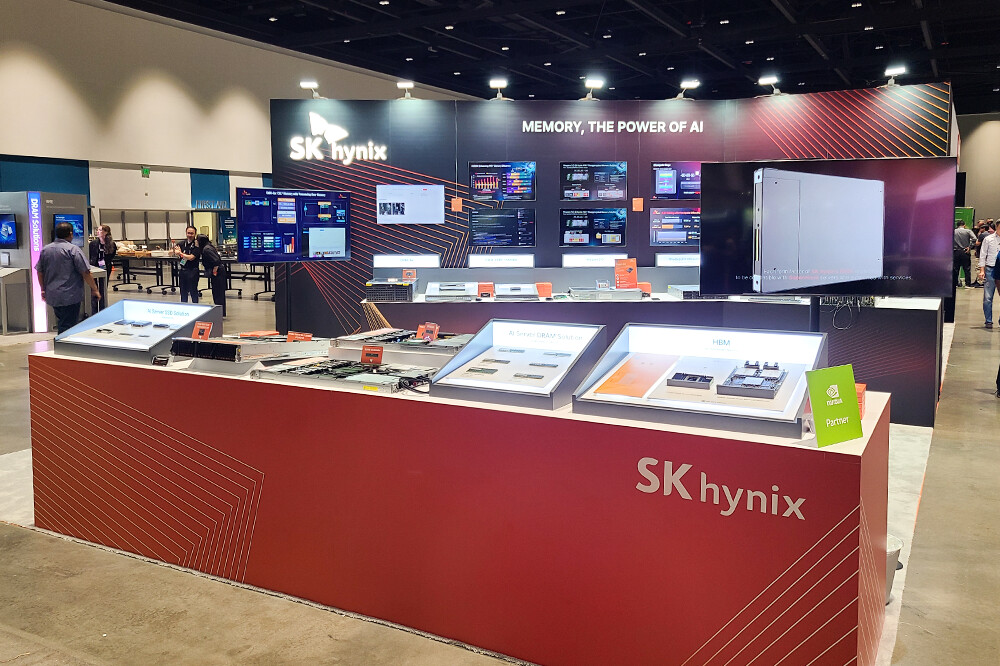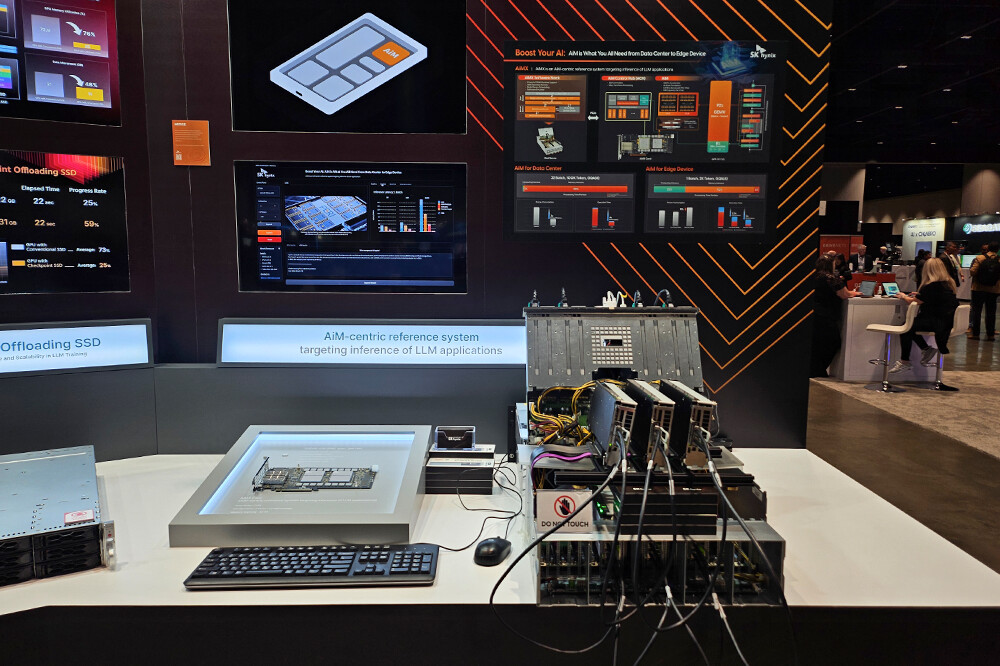SK hynix is making waves at the 2024 OCP Global Summit with its AI and data center memory products, showcasing their advancements in memory technology and their role in shaping the future of technology.
- SK hynix is showcasing AI and data center memory products at the OCP Global Summit, demonstrating their commitment to staying at the forefront of technology.
- They are deepening partnerships and sharing their knowledge of AI memory through a series of presentations, showing their dedication to collaboration and knowledge sharing in the industry.
- Their products, such as the CMM-Ax and AiMX, are designed to enhance compute memory for AI infrastructure, making it easier to process multiple types of data simultaneously and improving overall efficiency.
At the 2024 Open Compute Project (OCP) Global Summit, taking place from October 15-17 in the bustling tech hub of SAN Jose, California, SK hynix is making waves with its AI and data center memory products. This annual gathering is a hotspot for industry leaders, where conversations about open-source hardware and data center technology flow as freely as the coffee. The theme this year—”From Ideas to Impact”—captures the essence of what these innovators are trying to achieve: turning theoretical concepts into tangible technologies that can reshape our digital landscape.
As I wandered through the exhibit hall, I couldn’t help but notice the palpable excitement around SK hynix’s booth. They’re not just showing off their latest memory products; they’re also deepening partnerships and sharing their knowledge of AI memory through a series of presentations. In fact, they’ve ramped up their sessions this year, hosting eight discussions compared to just five in 2023. Topics range from High Bandwidth Memory (HBM) to CXL Memory Modules (CMS), and if you’re scratching your head at those acronyms, don’t worry—I’ll break it down.
One product that caught my eye was the CMM-Ax, previously known as CMS 2.0. It’s a mouthful, but the essence is simple: it’s designed to enhance compute memory for AI infrastructure, especially for applications that require processing multiple types of data simultaneously. Picture it like a Swiss Army knife for data centers, ready to tackle diverse tasks with ease.
The demonstrations at the booth were nothing short of impressive. One highlight was the live showcase of the GDDR6-AiM-based accelerator card, AiMX, which was running Meta’s latest large language model, Llama3 70B. Now, if you’re not familiar with large language models, think of them as advanced algorithms that can understand and generate human-like text. The challenge here? As these models generate longer responses, the computational demands on GPUs (the powerful chips that handle graphics and data processing) increase, which can slow things down. But during the demo, AiMX showed that it can manage this load efficiently, processing requests from multiple users without breaking a sweat. It’s a bit like having a highly skilled waiter who can juggle orders from a crowded restaurant without dropping a single plate.
In addition to the AiMX, SK hynix showcased its HBM3E memory alongside nVidia’s H200 Tensor Core GPU and the impressive GB200 Grace Blackwell Superchip. If you’ve ever wondered what fuels the rapid advances in AI and data centers, this is part of the answer. They also displayed their DDR5 RDIMM and MCR DIMM server DRAM, which are designed to meet the ever-growing demands of AI-driven applications. The DDR5 products on display are particularly noteworthy; they include the world’s first DDR5 DRAM built using the 1c node, a significant leap in technology that promises better performance and energy efficiency.
And let’s not overlook the SSDs. The Gen5 eSSDs PS1010 and PS1030, along with the Gen4 PE9010, were on display, boasting ultra-fast read/write speeds that are crucial for powering AI training and inference in large-scale environments. In a world where every millisecond counts, these innovations are like upgrading from a bicycle to a high-speed train.
As I wrapped up my visit to SK hynix’s booth, I couldn’t help but reflect on the broader implications of these advancements. It’s clear that SK hynix is not just keeping pace with the rapid evolution of AI and data center technologies; they’re helping to lead the charge. The innovations being showcased here could very well shape the future of how we interact with technology, making it faster, more efficient, and ultimately more capable of handling the complex demands of our data-driven world.
So, as we move from ideas to impact, it’s worth asking: how will these advancements redefine our relationship with technology? The answers are unfolding right here at the OCP Global Summit.

















About Our Team
Our team comprises industry insiders with extensive experience in computers, semiconductors, games, and consumer electronics. With decades of collective experience, we’re committed to delivering timely, accurate, and engaging news content to our readers.
Background Information
About nVidia:
NVIDIA has firmly established itself as a leader in the realm of client computing, continuously pushing the boundaries of innovation in graphics and AI technologies. With a deep commitment to enhancing user experiences, NVIDIA's client computing business focuses on delivering solutions that power everything from gaming and creative workloads to enterprise applications. for its GeForce graphics cards, the company has redefined high-performance gaming, setting industry standards for realistic visuals, fluid frame rates, and immersive experiences. Complementing its gaming expertise, NVIDIA's Quadro and NVIDIA RTX graphics cards cater to professionals in design, content creation, and scientific fields, enabling real-time ray tracing and AI-driven workflows that elevate productivity and creativity to unprecedented heights. By seamlessly integrating graphics, AI, and software, NVIDIA continues to shape the landscape of client computing, fostering innovation and immersive interactions in a rapidly evolving digital world.

Latest Articles about nVidia
About SK hynix:
SK Hynix is a important South Korean semiconductor company known for its innovative contributions to the global technology landscape. Specializing in the production of memory solutions, SK Hynix has played a vital role in shaping the semiconductor industry. With a commitment to research and development, they have continuously pushed the boundaries of memory technology, resulting in products that power various devices and applications.

Latest Articles about SK hynix
Technology Explained
Blackwell: Blackwell is an AI computing architecture designed to supercharge tasks like training large language models. These powerful GPUs boast features like a next-gen Transformer Engine and support for lower-precision calculations, enabling them to handle complex AI workloads significantly faster and more efficiently than before. While aimed at data centers, the innovations within Blackwell are expected to influence consumer graphics cards as well
Latest Articles about Blackwell
DDR5: DDR5 (Double Data Rate 5) is the next generation of memory technology for the computer industry. It is a modern day improvement on earlier DDR technologies, with faster speeds, greater bandwidth and higher capacities. DDR5 enables higher resolution, seamless gaming experiences and faster data transfer rates, making it an ideal choice for high-performance computing and 4K gaming. With its greater RAM compatibility, DDR5 provides faster buffering times and raised clock speeds, giving users an improved overall work system. DDR5 is also optimized for multi-tasking, allowing users to multitask without experiencing a significant drop in performance, increasing the productivity of digital tasks. As an ever-evolving technology, DDR5 is paving the way for the computer industry into a new and powerful era.
Latest Articles about DDR5
GDDR6: GDDR6 stands for Graphics Double Data Rate 6th generation memory. It is a high performance memory used in graphics cards and graphics processing units (GPUs), specifically targeting gaming, AI and deep learning-related applications. GDDR6 achieves higher bandwidth than previous generations, allowing faster and smoother gaming experience for users. It is also more power efficient, resulting in lower energy consumption overall. The improved power efficiency makes it adaptable to today's needs of thinner laptops and ultra-high definition gaming laptops. Additionally, GDDR6 is used in storage solutions and advanced data center applications to help streamline large amounts of data at lightning-fast speeds.
Latest Articles about GDDR6
GPU: GPU stands for Graphics Processing Unit and is a specialized type of processor designed to handle graphics-intensive tasks. It is used in the computer industry to render images, videos, and 3D graphics. GPUs are used in gaming consoles, PCs, and mobile devices to provide a smooth and immersive gaming experience. They are also used in the medical field to create 3D models of organs and tissues, and in the automotive industry to create virtual prototypes of cars. GPUs are also used in the field of artificial intelligence to process large amounts of data and create complex models. GPUs are becoming increasingly important in the computer industry as they are able to process large amounts of data quickly and efficiently.
Latest Articles about GPU
Grace Blackwell: Grace Blackwell is a cutting-edge technology that has revolutionized the computer industry. It is a type of artificial intelligence that is designed to mimic human cognitive abilities, such as learning, problem-solving, and decision-making. This technology has been applied in various areas of the computer industry, including data analysis, natural language processing, and machine learning. For example, Grace Blackwell can analyze large amounts of data and identify patterns and trends, making it a valuable tool for businesses to make informed decisions. It can also understand and respond to human language, making it useful for virtual assistants and chatbots. Additionally, Grace Blackwell can continuously learn and improve its performance, making it an invaluable asset in the development of new technologies. Overall, Grace Blackwell has greatly enhanced the capabilities of computers and has opened up new possibilities for the future of technology.
Latest Articles about Grace Blackwell
HBM3E: HBM3E is the latest generation of high-bandwidth memory (HBM), a type of DRAM that is designed for artificial intelligence (AI) applications. HBM3E offers faster data transfer rates, higher density, and lower power consumption than previous HBM versions. HBM3E is developed by SK Hynix, a South Korean chipmaker, and is expected to enter mass production in 2024. HBM3E can achieve a speed of 1.15 TB/s and a capacity of 64 GB per stack. HBM3E is suitable for AI systems that require large amounts of data processing, such as deep learning, machine learning, and computer vision.
Latest Articles about HBM3E
SAN: A Storage Area Network (SAN) is a high-speed and specialized network architecture designed to facilitate the connection of storage devices, such as disk arrays and tape libraries, to servers. Unlike traditional network-attached storage (NAS), which is file-based, SAN operates at the block level, enabling direct access to storage resources. SANs are known for their performance, scalability, and flexibility, making them ideal for data-intensive applications, large enterprises, and environments requiring high availability. SANs typically employ Fibre Channel or iSCSI protocols to establish dedicated and fast communication paths between servers and storage devices. With features like centralized management, efficient data replication, and snapshot capabilities, SANs offer advanced data storage, protection, and management options. Overall, SAN technology has revolutionized data storage and management, enabling organizations to efficiently handle complex storage requirements and ensure reliable data access.
Latest Articles about SAN
Trending Posts
MediaTek introduces Kompanio Ultra SoC, Aiming to Enhance AI in Chromebook Plus
GeForce Now Expands Library in April, Features South of Midnight Early Access
Xbox Game Pass April Preview: Discover South of Midnight, Blue Prince, and Borderlands 3
Nintendo Switch 2 makes official debut on June 5th, marking a new era in gaming
Samsung Expands Its Footprint in the U.S. Gaming Scene with Odyssey 3D
Evergreen Posts
NZXT about to launch the H6 Flow RGB, a HYTE Y60’ish Mid tower case
Intel’s CPU Roadmap: 15th Gen Arrow Lake Arriving Q4 2024, Panther Lake and Nova Lake Follow
HYTE teases the “HYTE Y70 Touch” case with large touch screen
NVIDIA’s Data-Center Roadmap Reveals GB200 and GX200 GPUs for 2024-2025
Intel introduces Impressive 15th Gen Core i7-15700K and Core i9-15900K: Release Date Imminent
